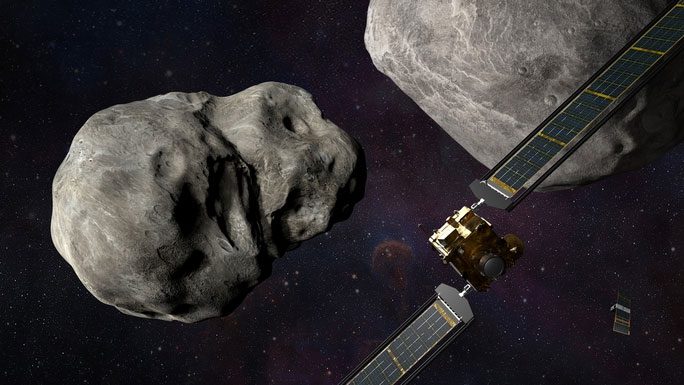After the collision with the “suicide” spacecraft DART, the famous asteroid Dimorphos did not follow the trajectory predicted by the models meticulously developed by NASA.
According to Live Science, a report recently presented at a meeting of the American Astronomical Society shows that the asteroid Dimorphos has been continuously tumbling on its old orbit around the parent asteroid Didymos and has been gradually slowing down for at least one month after the impact with NASA’s DART spacecraft.
Dimorphos was a frequently mentioned name in 2022, during a groundbreaking Earth defense experiment conducted by NASA.

NASA’s DART spacecraft heading straight for Dimorphos (left) – (Graphic: NASA).
NASA’s Double Asteroid Redirection Test (DART) involves a spacecraft of the same name tasked with targeting the smaller of the near-Earth asteroid pair Dimorphos – Didymos.
In this pair, Dimorphos acts as a small moon orbiting Didymos. Models predicted that neither would pose a threat to Earth in the near term, but its position was perfect for an experimental mission.
With the hypothetical scenario that Dimorphos was dangerous, NASA’s DART spacecraft – in a suicide mission – crashed directly into this asteroid with the aim of pushing it off its old orbit.
The initial test was successful and the asteroid began to change its orbit and speed immediately after the collision. However, it did not change in the way anticipated.
The new findings were made by high school teacher Jonathan Swift and his students. This study also indicates that the asteroid appears to have slowed down by up to 1 minute in its orbit after the collision just one month later, and then seemed to self-balance.
Its slowdown is also inconsistent. According to Mr. Swift, this may be due to the “cloud” of debris created by the collision, which NASA previously stated was very extensive, continuously causing small impacts on the asteroid throughout the first month.
Meanwhile, NASA’s DART team calculated that this asteroid had slowed down by only 15 seconds, with preliminary results announced quite early after the test.
Since then, Dimorphos and its parent asteroid, along with the debris, have been closely monitored by the space agency. The DART team plans to release its report next week.
However, to get a complete answer about the impact of the attack, we will have to wait until 2026, when the Hera spacecraft from the European Space Agency (ESA) approaches Dimorphos for a direct investigation, in a collaborative mission with NASA.


















































